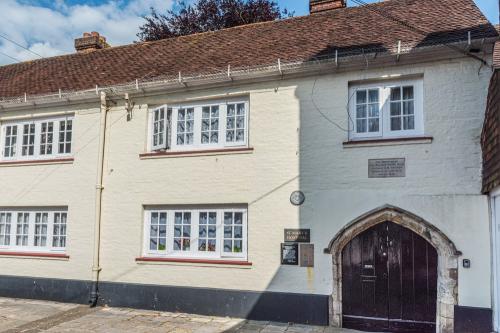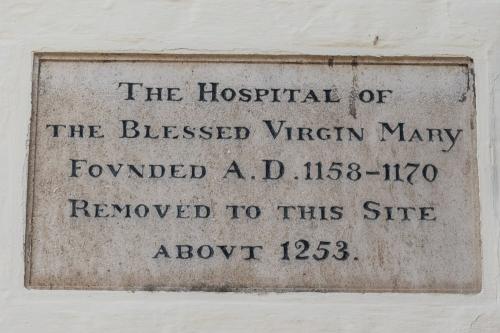
St Mary's Hospital is not a hospital in the modern sense of the word, but a medieval almshouse, offering accommodation to poor residents of Chichester, a role it has fulfilled since the 12th century, making it the oldest almshouse in continuous use anywhere in England.
History
According to the stone plaque over the almshouse entrance on St Martin Square, the official name of the Hospital is 'The Hospital of the Blessed Virgin Mary', but the name most commonly in use today is simply 'St Mary's Hospital Almshouses'.
That plaque goes on to say that the hospital was founded between 1158-1170 and moved to its current site around 1253. Those dates are very much open to debate, but it seems clear that the hospital was established on another site, probably sometime in the reign of Henry II (1154-1189) by William, Dean of Chichester Cathedral.
Refounding the Hospital
We know that the hospital pre-dates the buildings it now occupies because a written record of the hospital statutes exists from the period between 1232-1248, when it was refounded by Thomas of Lichfield, the serving Dean of Chichester.
In 1229 the Crown granted a license to tear down the church of St Peter, which stood in the market. St Peter's parish had just two parishioners, and these were assigned to St Mary's Hospital.
The hospital seems to have been associated with the church of St Mary-in-the-Market, which must have stood near the site of the present market cross.
The 13th-century almshouse had accommodation for 13 residents, both male and female, and both healthy and ill. These residents were under the direction of a prior, or master, who had the sole right to determine whether someone was suitable for admission. The focus was on offering overnight accommodation for the poor, rather than on providing permanent accommodation.

All hospital inmates had to swear vows of obedience, poverty, and chastity. Interestingly, there was no provision for a full-time priest, however, a local benefactor subsequently granted the hospital lands whose income was to be used to keep a full-time chaplain.
The new Hospital site
In 1269, the Franciscan Friars Minor left their friary buildings on St Martin's Square to establish a new friary on the site of Chichester Castle, in what is now Priory Park. The Franciscans' former buildings were given to St Mary's Hospital to form their new base.
It is not clear exactly when the hospital was moved to their new site, but some historians think this tool place in 1290, when they were granted the right to close off a public footpath that ran through the property.
Medieval Mismanagement
The hospital seems to have suffered from mismanagement, for visitations in 1382 and 1402 found a number of faults, including failure to provide a weekly payment of a groat to inmates. From 1478 the number of inmates never exceeded five, plus a chaplain and warden.
From 1528 the hospital warden had to be a priest and he had to visit at least monthly. He also had to show the hospital accounts to the dean and chapter at the cathedral. The number of aged and infirm residents was limited to five, one of whom was elected to be prior, or master.
From the Tudor period, the hospital provided a haven for permanent residents rather than indigent overnight visitors.
The hospital managed to survive the religious turmoil of the Reformation and was refounded by Queen Elizabeth I in 1582. Oliver Cromwell placed the hospital under the care of the mayor and corporation of Chichester but control reverted to the dean and chapter of the cathedral upon the Restoration of the Monarchy.
The hospital suffered from poor administration over the centuries and it seems likely that funds went directly into the warden's pocket.
Wardens of St Mary's Hospital Almshouses to 1902:
Henry, recorded in 1230
Walter, recorded in 1248-63
Robert de Kyngeston, recorded in 1272 and 1279
Gilbert, recorded in 1285
Walter, recorded in 1288
Gilbert, recorded in 1298
Richard le Orfevre, appointed 1301, recorded in 1304
William de Selebourne, recorded in 1316
Thomas, recorded in 1343
Alan de Leverton, appointed 1385
Walter Forey, recorded in 1389
John Courderay, appointed 1389
John Ayleston, recorded in 1412
John Croucher, resigned 1447
John Goswell, appointed 1447
John Champion, 1475
Ivo Darrell, recorded in 1478
William Fleshmonger, 1525
John Champion, recorded in 1528 and 1535
John Worthyall, recorded in 1537 and 1542
John Peterston, B.D., 1554
William Pye, 1555
George Beaumont, D.D., 1558
Hugh Turnbull, D.D., 1559
Edmund Weston, LL.B., 1567
William Overton, D.D., 1570
Richard Kitson, B.D., 1580
Randoll Barlow, 1585
Francis Cox, D.D., 1602
Hugh Perrin, 1606
Henry Challen, 1610
Humphrey Booth, M.A., 1613
Bruno Ryves, 1660
Oliver Whitby, D.D., 1666
Henry Edes, D.D., 1679
William Hayley, D.D., 1703
Edmund Gibson, D.D., 1715
John Wright, M.A., 1717
Thomas Hayley, D.D., 1720
Thomas Sherlock, D.D., 1723
William Sherwin, M.A., 1728
Thomas Gooch, D.D., 1735
Thomas Ball, M.A., 1738
William Clarke, M.A., 1754
Thomas Hurdis, D.D., 1770
John Frankland, M.A., 1772
Charles Harward, M.A., 1778
John Courtail, M.A., 1784
Combe Miller, M.A., 1806
Moses Toghill, M.A., 1814
Charles Webber, M.A., 1825
Thomas Baker, M.A., 1828
Charles Edward Hutchinson, 1829
Charles Webber, junr., 1832
George Shiffner, 1837
Charles Webber, Jr., 1849
Charles Edward Hutchinson, 1850
Charles Pilkington, 1864
Charles Anthony Swainson, D.D., 1870
John Russell Walker, M.A., 1882
Thomas Francis Crosse, D.C.L., 1889
Josiah Sanders Teulon, M.A., 1889
James Hoare Masters, M.A., 1902
The Hospital Today
The centrepiece of the hospital complex that we see today is the medieval hospital building, completed sometime around 1292 and boasting a timber-framed roof supported on massive beams, soaring 40 feet high, with a chapel at one end of the structure. It resembles nothing so much as a medieval tithe barn in appearance.
The building originally consisted of a long hall that served as accommodation for the residents (known as brothers and sisters), with a chapel at the east end. This basic plan was common amongst medieval hospitals, which often combined care for the poor and sick with religious functions. The chapel is home to a series of 13th-century misericords.
The original medieval layout was a simple barnlike building, but this was adapted in the 17th century to create eight one-bedroom flats. Four chimneys were inserted, providing fireplaces in back-to back flats.
The two westernmost bays of the hospital building were pulled down in the late Victorian period to create an entrance courtyard. The layout was changed again in the 20th century to provide five flats, available to house poor widows.
Facing onto St Martin's Square are St Mary's Cottages. These offer married quarters to residents.
The hospital trust owns property around Chichester, and the income from these properties helps maintain and administer the almshouses.
Visiting
Visitors are welcome, but access is limited to guided tours, available on designated days throughout the year. For current tour dates and details, please see the official website. Note that capacity on each tour is limited to 12 people. Special tours for larger groups may be available by prior arrangement. Again, see the official website for details.
If you can't manage a tour, you can still see the hospital exterior on St Martin's Square, a very short stroll from North Street and the city centre. The closest public car park is in Little London, behind Marks and Spencer's.
About St Mary's Hospital Almshouses, Chichester
Address: St Martin's Square,
Chichester,
West Sussex,
England, PO19 1NR
Attraction Type: Historic Building
Location: On St Martin's Square, a short walk from North Street and the city centre. The nearest car park is in Little London.
Website: St Mary's Hospital Almshouses, Chichester
Location
map
OS: SU862049
Photo Credit: David Ross and Britain Express
POPULAR POSTS
HERITAGE
 We've 'tagged' this attraction information to help you find related historic attractions and learn more about major time periods mentioned.
We've 'tagged' this attraction information to help you find related historic attractions and learn more about major time periods mentioned.
Find other attractions tagged with:
NEARBY HISTORIC ATTRACTIONS
Heritage Rated from 1- 5 (low to exceptional) on historic interest
Chichester Council House - 0.1 miles (Historic Building) ![]()
Chichester, St Olave's Church - 0.1 miles (Historic Church) ![]()
Chichester Guildhall - 0.1 miles (Historic Church) ![]()
Chichester Market Cross - 0.1 miles (Historic Building) ![]()
Pallant House Gallery - 0.1 miles (Museum) ![]()
Chichester Roman City Walls - 0.2 miles (Roman Site) ![]()
Chichester Castle - 0.2 miles (Castle) ![]()
Chichester, St John the Evangelist - 0.2 miles (Historic Church) ![]()
Nearest Holiday Cottages to St Mary's Hospital Almshouses, Chichester:
Runcton, West Sussex
Sleeps: 4
Stay from: £523 - 1517
More self catering near St Mary's Hospital Almshouses, Chichester



